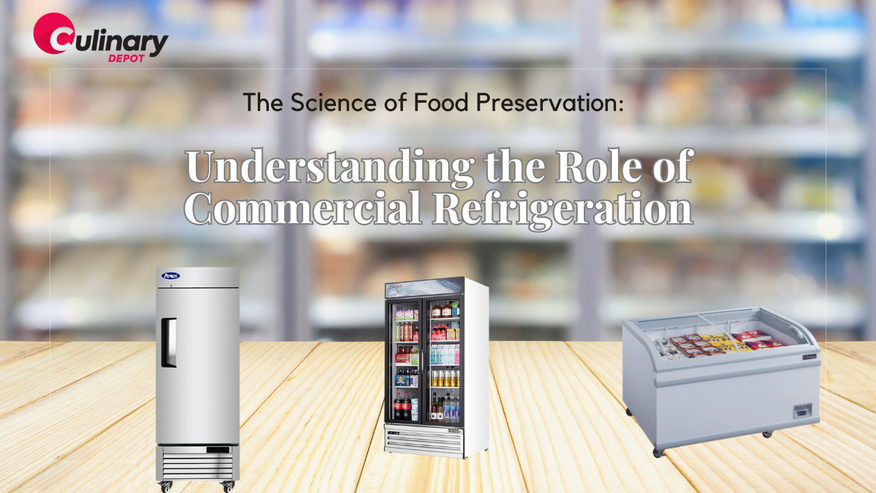Nov 2nd 2023 - Team Member
The Science of Food Preservation: Understanding the Role of Commercial Refrigeration
The world of commercial kitchens operates on a delicate balance of maintaining food safety, quality, and freshness. Central to this equilibrium is the often-underestimated hero - the commercial refrigerator. In this article, we will explore the fascinating science behind food preservation and understand how commercial refrigeration plays a pivotal role in this process.
The Basics of Food Preservation

Food preservation is an age-old practice that has evolved from rudimentary techniques like drying, salting, and fermenting to the sophisticated methods we use today. At its core, food preservation aims to control the factors that cause food to spoil: microorganisms, enzymes, and oxidation. By hindering these processes, we can extend the shelf life of various food items.
Temperature: The Key Player
One of the most critical aspects of food preservation is temperature control. Most of us are familiar with the basic principle that refrigeration helps slow down bacterial growth and spoilage. But let's dive deeper into the science behind it.
Bacteria thrive in a specific temperature range known as the 'danger zone,' which typically spans from 40°F (4.4°C) to 140°F (60°C). When food is stored within this range, bacteria multiply rapidly, leading to foodborne illnesses.
Refrigeration maintains a temperature below this danger zone, inhibiting bacterial growth. For instance, at 32°F (0°C), bacteria's growth rate is reduced significantly. At 0°F (-18°C), most bacteria become dormant, further extending the food's shelf life.
Humidity and Food Quality

It's not just the temperature; humidity also plays a vital role in food preservation. The right humidity levels help maintain the quality of food products.
In many commercial refrigerators, humidity is adjustable to suit different types of food. For example, leafy greens and vegetables require higher humidity to prevent wilting and maintain crispness, while dry goods like cheese and meat benefit from lower humidity to prevent moisture-related issues.
The Freezing Point
Freezers are a subset of commercial refrigeration that takes preservation to a whole new level. By reducing the temperature below the freezing point of water (32°F or 0°C), freezers halt the enzymatic reactions responsible for ripening and decay. As a result, frozen foods can have a remarkably long shelf life without compromising their quality.
Food Safety: Where Science Meets Technology
In the modern world, commercial refrigeration goes beyond maintaining the right temperature and humidity. It also involves cutting-edge technology to ensure food safety. For instance:
1. Temperature Monitoring:

- Commercial refrigerators are equipped with temperature sensors and alarms. These sensors constantly monitor the internal temperature and send alerts if it goes out of the safe range. This feature ensures that food products are always stored under the ideal conditions.
2. Airflow Control:
- Many commercial refrigeration units now use advanced airflow systems. These systems distribute chilled air evenly throughout the storage space, preventing temperature fluctuations and cold spots. This results in better preservation of food.
3. Energy Efficiency:
- Science has contributed to making commercial refrigeration more energy-efficient. Modern units are designed to consume less electricity while maintaining optimal conditions. This not only reduces operating costs but also minimizes the environmental impact.
4. Digital Inventory Management:
- Some commercial refrigeration systems integrate with digital inventory management software. This technology helps track food products, their shelf life, and when they need to be used or discarded. It minimizes waste and ensures that food stays fresh.
The Future of Food Preservation
As technology continues to advance, we can expect even more innovative solutions in commercial refrigeration. Smart refrigerators are already making their mark in commercial kitchens. These devices can autonomously adjust temperature and humidity, issue alerts, and even connect to inventory management systems.
In conclusion, the science behind food preservation is both fascinating and complex. Commercial refrigeration is at the forefront of this science, providing precise control over temperature and humidity to extend the shelf life of food while maintaining its quality and safety. Understanding this science allows chefs, restaurant owners, and foodservice professionals to make informed choices when selecting and using commercial refrigeration equipment.
So, the next time you enjoy a crisp salad, a perfectly aged steak, or a scoop of your favorite ice cream, you'll know that it's not just the recipe but also the precise science of commercial refrigeration that contributes to that delightful experience.

